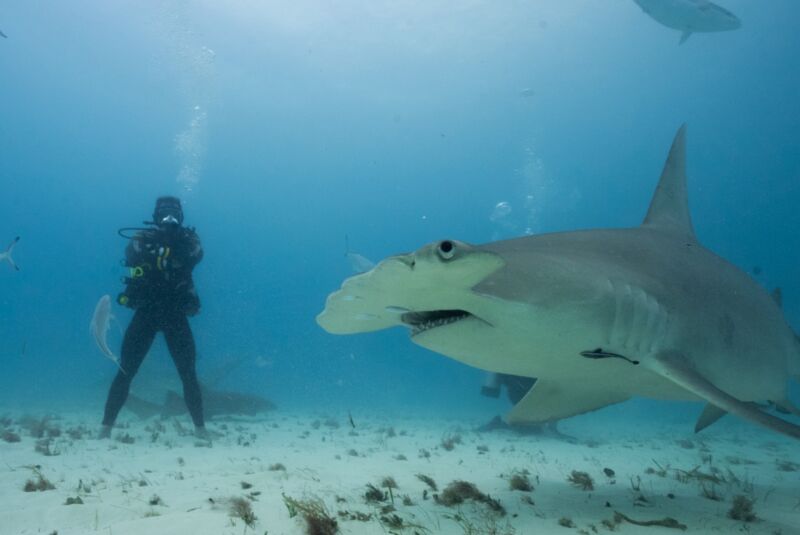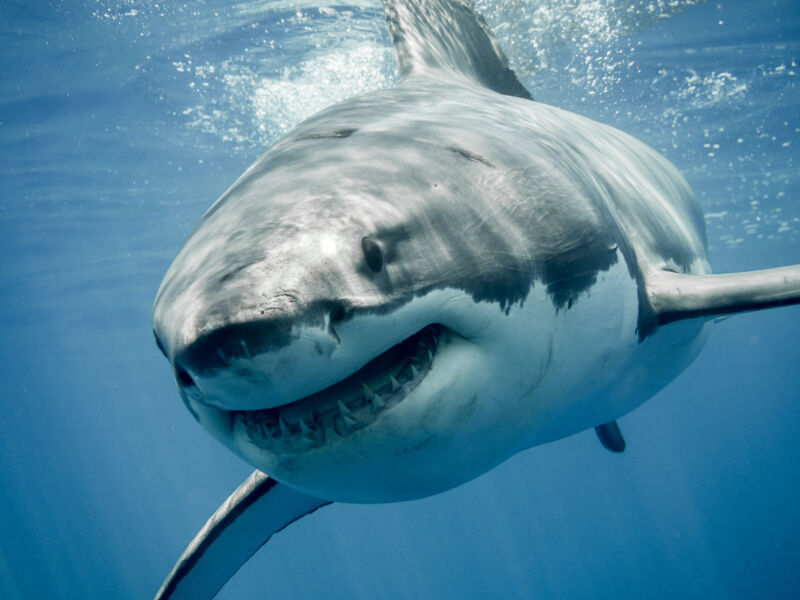FilmSharks Clinches Theatrical Deals for Hugo J. Cardozo’s ‘Do Not Enter,’ Bows International Trailer Ahead of Busan Premiere (EXCLUSIVE)



Enlarge / Great white sharks can reduce drag at different swimming speeds thanks to high and low ridged denticles in its skin. (credit: Terry Goss/CC BY 2.5)
The great white shark (Carcharodon carcharias) is a swift and mighty hunter, capable of reaching speeds as high as 6.7 m/s when breaching, although it prefers to swim at slower speeds for migration and while waiting for prey. A team of Japanese researchers has studied the structure of the great white's skin to learn more about how these creatures adapt so well to a wide range of speeds. Their findings could lead to more efficient aircraft and boats with greatly reduced drag, according to a recent paper published in the Journal of the Royal Society Interface.
As previously reported, anyone who has touched a shark knows the skin feels smooth if you stroke from nose to tail. Reverse the direction, however, and it feels like sandpaper. That's because of tiny translucent scales, roughly 0.2 millimeters in size, called "denticles" (because they strongly resemble teeth) all over the shark's body, especially concentrated in the animal's flanks and fins. It's like a suit of armor for sharks, and it also serves as a means of reducing drag in the water while swimming.
Pressure drag is the result of flow separation around an object, like an aircraft or the body of a mako shark as it moves through water; the magnitude of pressure drag is determined by the shape of the object. It's what happens when the fluid flow separates from the surface of an object, forming eddies and vortices that impede the object's movement. Since the shark's body is constantly undulating as it swims, it needs something to help keep the flow attached around that body to reduce that drag. Denticles serve that purpose.

Enlarge / Extreme sportsman Ross Edgley comes face to face with a great hammerhead shark in the waters of Bimini in the Bahamas. (credit: National Geographic/Nathalie Miles)
Ultra-athlete Ross Edgley is no stranger to pushing his body to extremes. He once ran a marathon while pulling a 1-ton car; ran a triathlon while carrying a 100-pound tree; and climbed a 65-foot rope over and over again until he'd climbed the equivalent of Mt. Everest—all for charity. In 2016, he set the world record for the world's longest staged sea swim around the coastline of Great Britain: 1,780 miles over 157 days.
At one point during that swim, a basking shark appeared and swam alongside Edgley for a day and a half. That experience ignited his curiosity about sharks and eventually led to his new National Geographic documentary, Shark vs. Ross Edgley—part of four full weeks of 2024 SHARKFEST programming. Edgley matches his athletic prowess against four different species of shark. He tries to jump out of the water (polaris) like a great white shark; withstand the G forces produced by a hammerhead shark's fast, rapid turns; mimic the extreme fasting and feasting regimen of a migrating tiger shark; and match the swimming speed of a mako shark.
"I love this idea of having a goal and then reverse-engineering and deconstructing it," Edgley told Ars. "[Sharks are] the ultimate ocean athletes. We just had this idea: what if you're crazy enough to try and follow in the footsteps of four amazing sharks? It's an impossible task. You're going to fail, you're going to be humbled. But in the process, we could use it as a sports/shark science experiment, almost like a Trojan horse to bring science and ocean conservation to a new audience."

Enlarge (credit: RamonCarretero/Getty)
A hammerhead shark less than one meter long swims frantically in a plastic container aboard a boat in the Sanquianga National Natural Park, off Colombia’s Pacific coast. It is a delicate female Sphyrna corona, the world’s smallest hammerhead species, and goes by the local name cornuda amarilla—yellow hammerhead—because of the color of its fins and the edges of its splendid curved head, which is full of sensors to perceive the movement of its prey.
Marine biologist Diego Cardeñosa of Florida International University, along with local fishermen, has just captured the shark and implanted it with an acoustic marker before quickly returning it to the murky waters. A series of receivers will help to track its movements for a year, to map the coordinates of its habitat—valuable information for its protection.
That hammerhead is far from the only shark species that keeps the Colombian biologist busy. Cardeñosa’s mission is to build scientific knowledge to support shark conservation, either by locating the areas where the creatures live or by identifying, with genetic tests, the species that are traded in the world’s main shark markets.